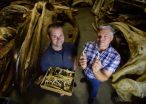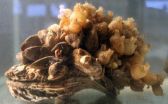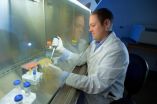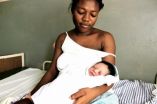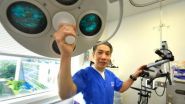(Press-News.org) Alexandria, Va. — Earth's largest active volcano, Mauna Loa on Hawaii's Big Island, is taking a nap. And after 30 years, no one is sure when the sleeping giant will awaken. Scientists say it's likely to erupt again within the next couple of decades and, when it does, it will be spectacular — and potentially dangerous.
Although Mauna Loa often takes a back seat to the more famous Kilauea, which has been erupting nearly continuously since 1983, history warns us that Mauna Loa's current silence is anomalous. Meanwhile, more people and more buildings pack into potentially hazardous areas: locations where Mauna Loa's lava has reached in the past and likely will reach again. Read more about the steps geologists are already taking — such as upgrading their monitoring tools and talking with the public — to prepare for another eruption of Mauna Loa in the September issue of EARTH Magazine: http://bit.ly/1p1SXiU.
For more stories about the science of our planet, check out EARTH magazine online or subscribe at http://www.earthmagazine.org. The September issue, now available on the digital newsstand, features stories about a new Neanderthal ancestor found in a Spanish cave, the effect of volcanic ash on Southern Ocean plankton, and a tribute to Nereus, the United States' only full-ocean-depth submersible, which was lost at sea in May, plus much, much more.
INFORMATION:
Keep up to date with the latest happenings in Earth, energy and environment news with EARTH magazine online at: http://www.earthmagazine.org/. Published by the American Geosciences Institute, EARTH is your source for the science behind the headlines.
The American Geosciences Institute is a nonprofit federation of 49 geoscientific and professional associations that represents more than 250,000 geologists, geophysicists and other earth scientists. Founded in 1948, AGI provides information services to geoscientists, serves as a voice of shared interests in the profession, plays a major role in strengthening geoscience education, and strives to increase public awareness of the vital role the geosciences play in society's use of resources, resiliency to natural hazards, and interaction with the environment.
Living in the shadow of Mauna Loa: A silent summit belies a volcano's forgotten fury
2014-09-08
ELSE PRESS RELEASES FROM THIS DATE:
Whale sex: It's all in the hips
2014-09-08
Both whales and dolphins have pelvic (hip) bones, evolutionary remnants from when their ancestors walked on land more than 40 million years ago. Common wisdom has long held that those bones are simply vestigial, slowly withering away like tailbones on humans.
New research from USC and the Natural History Museum of Los Angeles County (NHM) flies directly in the face of that assumption, finding that not only do those pelvic bones serve a purpose – but their size and possibly shape are influenced by the forces of sexual selection.
"Everyone's always assumed that if you ...
Study puts some mussels into Bay restoration
2014-09-08
Restoring oysters—and their ability to filter large volumes of water—is widely seen as a key way to improve the health of Chesapeake Bay. New research makes this calculus even more appealing, showing that the mussels that typically colonize the nooks and crannies of a restored oyster reef can more than double its overall filtration capacity.
The study—by researchers at the University of Maryland, the Smithsonian Environmental Research Center, and the Virginia Institute of Marine Science—appears as the cover story in the most recent issue of Restoration Ecology.
"Many ...
New targets for treating pulmonary hypertension found
2014-09-08
Two new potential therapeutic targets for the treatment of pulmonary arterial hypertension, a deadly disease marked by high blood pressure in the lungs, have been identified by researchers at the University of Illinois at Chicago. Their findings are reported in the American Journal of Respiratory and Critical Care Medicine.
Early symptoms of pulmonary arterial hypertension include shortness of breath and exercise intolerance. As the disease progresses, patients may require oxygen supplementation and lung transplantation. Heart failure can develop and is a major cause of ...
New compound inhibits enzyme crucial to MERS and SARS viruses, with a catch
2014-09-08
Scientists at the University of Illinois, Chicago, have identified a compound that effectively inhibits an enzyme crucial to the viruses that cause Middle East respiratory syndrome (MERS) and severe acute respiratory syndrome (SARS). The compound appears to have a different method of inhibition in each virus due to slight differences in each virus' enzyme which means finding other compounds that inhibit both may be difficult according to research presented at the 54th Interscience Conference on Antimicrobial Agents and Chemotherapy (ICAAC) an infectious disease meeting ...
How quickly viruses can contaminate buildings and how to stop them
2014-09-08
Using tracer viruses, researchers found that contamination of just a single doorknob or table top results in the spread of viruses throughout office buildings, hotels, and health care facilities. Within 2 to 4 hours, the virus could be detected on 40 to 60 percent of workers and visitors in the facilities and commonly touched objects, according to research presented at the 54th Interscience Conference on Antimicrobial Agents and Chemotherapy (ICAAC), an infectious disease meeting of the American Society for Microbiology.
There is a simple solution, though, says Charles ...
A low-energy optical circuit for a new era of technology
2014-09-08
Unlike electronic circuits, optical, or "photonic", circuits work with light rather than electricity, which makes them 10 to 100 times faster. They are also more energy-efficient because they show lower heat loss, better signal-to-noise ratios and are less susceptible to interference. Used especially for communications (e.g. fiber optics), optical circuits may use tiny optical cavities as 'switches' that can block or allow the flow of light, similarly to transistors in electronics. EPFL scientists have now fabricated and experimentally tested a silicon-based 'photonic crystal ...
To admit or not to admit: Variation in hospitalizations from ER costs billions
2014-09-08
ANN ARBOR, Mich. — It sounds like the setup for a joke: Two identical patients go to two different hospital emergency entrances, complaining of the same symptoms.
But what happens next is no laughing matter, according to a new University of Michigan study published in the September issue of Health Affairs. While one patient may get treated and released from the emergency department, the other gets sent upstairs to a hospital bed – at a cost of tens of thousands of dollars.
In fact, doctors at one hospital may be as much as six times as likely to admit an emergency ...
Scientists reveal cell secret potentially useful for vaccines
2014-09-08
The best defense is a good offense, especially when it comes to the immune system. The troops that respond to an infection are split into two squadrons, and, until recently, it seemed that the two were independent, without much interaction.
Now, in a paper published this week in Nature Immunology, a team of scientists from the Virginia Tech Carilion Research Institute and the University of Alabama at Birmingham say that the immunology boot camp is more communication-intensive than initially thought — a discovery that could help efforts to produce more effective vaccines.
"We ...
Women and health professionals spark new cycle of improving maternal and newborn health
2014-09-08
Demand for better care by women linked with the expansion of basic services, rather than political pressure, has helped to improve midwifery services in low to middle-income countries, according to international research involving the University of Southampton.
An examination of maternal and newborn health systems for the Lancet Series on Midwifery found that after initial investment in maternal and newborn health infrastructure, a virtuous cycle developed in these countries – with increased demand for care leading to the deployment of more midwives, better services, ...
Facial plastic surgery can safely address the major aspects of aging in 1 operation
2014-09-08
AUGUSTA, Ga. – A total facial rejuvenation that combines three procedures to address the multiple signs of an aging face and neck can be performed safely at one time, a new study shows.
Total facial rejuvenation, which combines an extensive facelift to tighten skin and muscle; specialized, midface implants to restore fullness; and laser resurfacing to reduce skin's irregular texture and discoloration, can be safely performed at one time, reports Dr. Achih H. Chen, facial plastic surgeon.
Chen, Director of Facial Plastic and Reconstructive Surgery at the Medical ...
